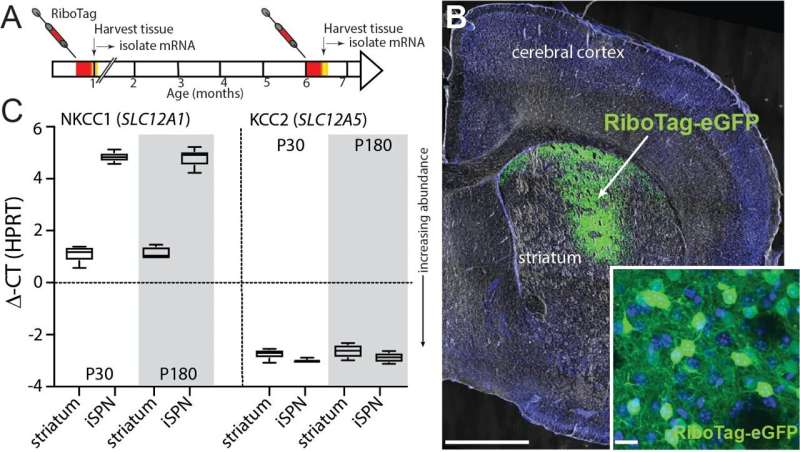This article has been reviewed according to Science X's editorial process and policies. Editors have highlighted the following attributes while ensuring the content's credibility:
fact-checked
trusted source
proofread
A calming neurotransmitter can also be excitatory, study finds

A neurotransmitter previously thought only to calm neurons may also play a role in waking them up, according to a study published in the journal PLOS Biology, a discovery which challenges the textbook view of how neurons communicate with one another in the brain.
Gamma-aminobutyric acid, or GABA, is thought to be the principal inhibitory neurotransmitter in the brain, dampening a nerve cell's ability to communicate via chemical messages to other nerve cells. Thought to play a role in many if not all brain functions, GABA is often portrayed as working in opposition to glutamate, the most abundant excitatory neurotransmitter in the brain.
But according to the new study, GABA can both inhibit or excite neurons depending on the context, said D. James Surmeier, Ph.D., the Nathan Smith Davis Professor and chair of Neuroscience, who was senior author of the study.
"Textbooks treat synaptic transmission in a black-and-white way," Surmeier said. "Glutamatergic synaptic transmission is excitatory and GABAergic synaptic transmission is inhibitory. Our work shows that it is more complicated than that—at least for striatal spiny projection neurons."
In the study, investigators observed spiny projection neurons, a type of neuron which make up 95 percent of the cells in the striatum, an area of the brain involved in decision-making functions, including motor control, emotion and habit formation.
By observing the activity of spiny projection neurons using a non-invasive, perforated patch recording, scientists found that GABA could "wake up" neurons in a resting state, priming them for input from glutamate.
"We think GABA may serve to activate neurons that are 'sleeping,'" Surmeier said. "GABA can 'turn on' neurons in a way that had been thought that only glutamate could. Once a cell is paying attention to what other cells are saying to it, it can do its job in the striatal circuit."
The inhibitory nature of GABA only comes into play when neurons are close to the threshold for spiking, Surmeier said. In this way, GABA ensures the cells are responding only to the strongest, most salient inputs, reducing "neural noise." This is the conventional mode of GABA action.
"Our work provides a more nuanced view of how striatal circuits are working. Most people in the field simply thought GABA shuts the cells and circuits down and glutamate excites them," Surmeier said.
The discovery of GABA's multiple roles requires rethinking its classification as a strictly inhibitory neurotransmitter, Surmeier said, and has wider implications for artificial intelligence technology, which is largely based on overly simple models of how neurons communicate with one another.
"The neural network models upon which machine learning and artificial intelligence are based do not reflect what we know about brain circuitry today," Surmeier said. "They don't capture the computational complexity of individual neurons or how they communicate. The fact that one of the two major transmitters in the brain can have different functional consequences in different brain states has real implications for how artificial networks should be designed if they want to emulate human intelligence."
Moving forward, Surmeier and his collaborators will continue to study GABA's influence on spiny projection neurons and how the interactions are altered in diseases such as Parkinson's and Huntington's.
"Brain circuitry is altered in very different ways in these diseases, both of which involve motor dysfunction and pathophysiology in the stratum," Surmeier said.
"We're trying to identify what the contribution of these inter-neuronal circuits is to that dysfunction. It turns out that in the Parkinson's disease models, at least, that the GABAergic circuitry begins to rewire in ways we never expected."
More information: Michelle Day et al, GABAergic regulation of striatal spiny projection neurons depends upon their activity state, PLOS Biology (2024). DOI: 10.1371/journal.pbio.3002483



















